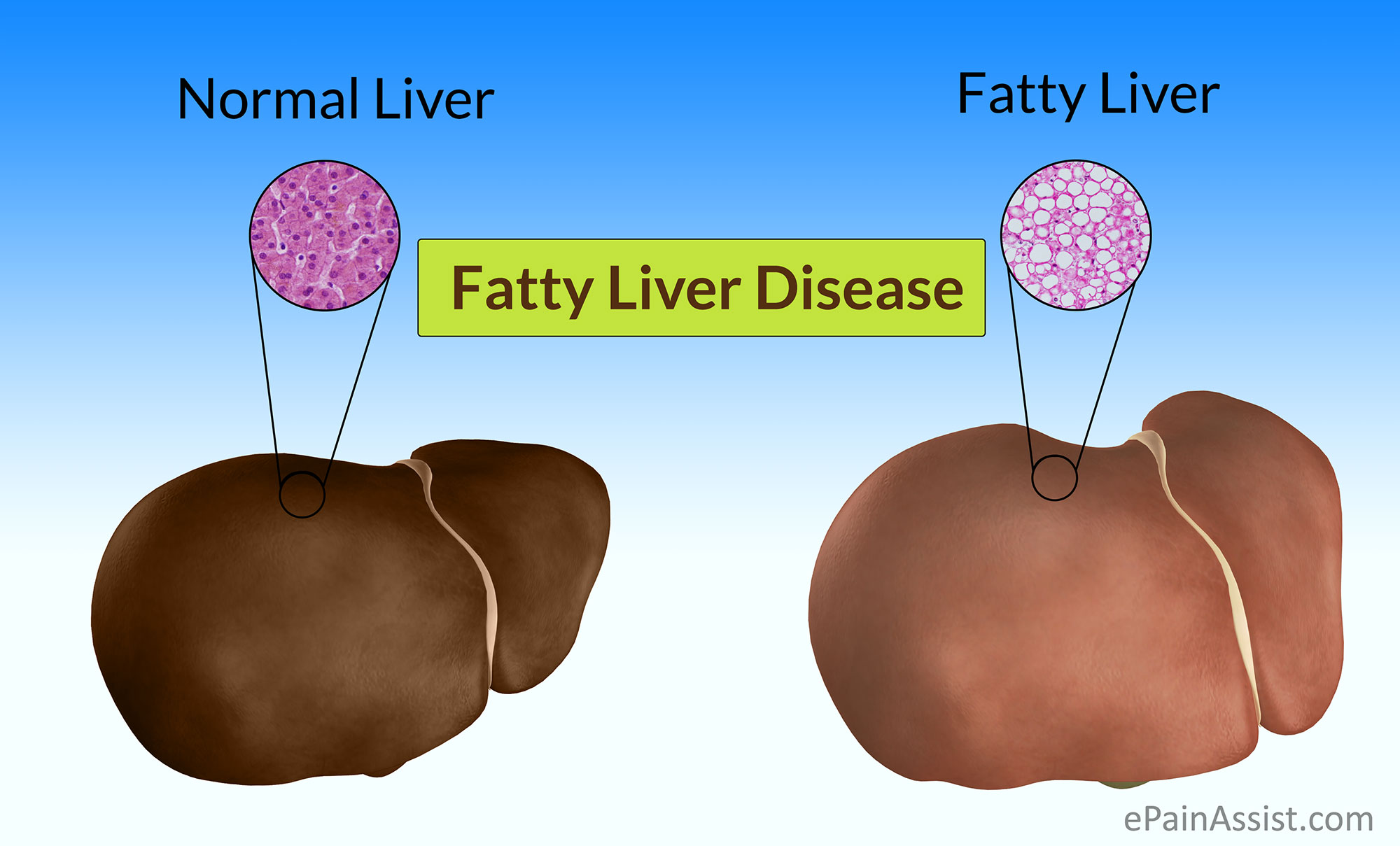Fatty Liver Disease (FLD) is caused by accumulation of fat in liver cells. Fatty liver disease is reversible disease. It is generally caused when an individual consumes more fat than the body can handle. It is usually a benign condition but if not treated appropriately may lead to complications. In this article, we will study about the various causes, symptoms, and treatment for Fatty Liver Disease (FLD).
How Is Fatty Liver Disease (FLD) Defined?
- Alcoholic Fatty Liver Disease (FLD)-
- Prolonged alcohol consumption causes cellular and mitochondrial damage in liver cells.
- The triglycerides and lipid molecules accumulates in liver cells causing fatty liver.
- Non-alcoholic Fatty Liver Disease (FLD)-
- Observed in obese and alcoholic patient.
- The disease is caused by over eating and consuming excessive fat.
- Cellular Changes-
- Triglycerides-
- Fat is accumulated as triglycerides in large vacuoles.
- Observed in both non-alcoholic and alcoholic fatty liver disease.
- Triglycerides-
- Intracellular Vesicles-
- Cellular changes observed are micro (small) and macro vesicular changes.
- Vesicles hold the triglycerides.1
- Observed in both non-alcoholic and alcoholic fatty liver disease.
- Mitochondrial Changes-
- Mitochondrial damages are seen in fatty liver disease caused by alcoholic fatty liver.2
- Hepatitis- Fatty liver disease may follow or can be associated with liver inflammation (hepatitis).
- Fat Accumulation in Liver- Disease is diagnosed as Fatty Liver Disease when fat accumulation in liver is over 10%.
- Benign Condition- Fatty Liver disease is a benign disease and does not cause any liver damage.
- Cirrhosis of Liver- Prolonged fatty liver disease if not treated causes inflammation and cellular damage, and results in cirrhosis of liver.
Causes of Fatty Liver Disease (FLD)
Non-alcoholic Fatty Liver Genetic Predisposition3
- Non-alcoholic fatty liver disease is most common fatty liver disease.
- Genetic mutation and abnormalities were identified with abnormal level of triglyceride and alkaline phosphatase enzymes.
- An enzyme abnormality causes abnormal fat deposition in liver.
Fatty Liver Disease (FLD) Caused Due To Obesity:
- 25% of obese patients are suffering with fatty liver.
- Obesity is one of the common cause of non-alcoholic fatty liver disease.4
- All obese patients do not have fatty liver disease, but few who may have a genetic variant promoting enzyme abnormalities and accumulation of fat in liver cells.
- High fat diet causing obesity also causes fatty liver disease.5
Fatty Liver Disease (FLD) Caused By Alcohol Consumption
- Alcohol interferes with fat metabolism in liver and results in accumulation of fat in liver cells.
- Alcohol damages mitochondria, which results in abnormal accumulation of fat in liver cells.2
Drugs and Medications Causing Fatty Liver Disease (FLD)
- Amiodarone
- Methotrexate
- Diltiazem
- Tetracycline
- Glucocorticoids
Endocrinal Disease Causing Fatty Liver Disease (FLD)-
Abnormal Fat Metabolism Causing Fatty Liver Disease (FLD)-
- High cholesterol
- High levels of triglycerides in the blood
Risk Factors Of Fatty Liver Disease (FLD)
- Protein deficiency
- Prolonged intravenous nutrition supply
- Intestinal bypass surgery
- Rapid weight loss
- Disease:
- Diabetes
- Hyperlipidemia
- Hypertension
- Inflammatory bowel disease
- HIV
- Hepatitis C
- Polycystic ovarian disease
Symptoms Of Fatty Liver Disease (FLD)
Non-Specific Symptoms of Fatty Liver Disease (FLD)-
- Obesity
- History of regular alcohol consumption
- Weakness
- Fatigue
- Loss of appetite
Specific Symptoms and Signs of Fatty Liver Disease (FLD)-
- Abdominal pain
- Nausea and vomiting
- Hepatomegaly- Enlarged liver
Diagnosis Of Fatty Liver Disease (FLD)
Urine Examination
- Yellow discoloration in advanced stages
- Increased bilirubin in urine
Blood Examination
- Increased serum bilirubin
- Increased cholesterol
- Increased triglycerides
- Elevated liver enzyme- SGOT and SGPT.
Radiological Studies-
- Ultrasound Studies- Enlarged liver.
- MRI- Enlarged liver and fatty infiltrate observed in liver.
- CT Scan- Enlarged liver and fatty infiltrate observed in liver
Treatment For Fatty Liver Disease (FLD)
- Hyperglycemia (high blood sugar)
- Monitor blood sugar regularly
- Treat hyperglycemia aggressively
- Discontinue alcohol consumption
- Restrict fatty food
- Balance diet
- Regular exercise
Prevention Of Fatty Liver Disease (FLD)
In order to prevent Fatty Liver Disease from occurring one can follow the following guidelines
- Choose a healthy lifestyle
- Avoid eating junk food which may make you overweight
- Religious and regular exercise schedule is imperative
- In case if an individual is obese, controlled weight loss is recommended
- Eating a well balanced diet
- Abstain from alcohol.
References:
1. Nonalcoholic fatty liver disease: diagnosis and management.
Wilkins T1, Tadkod A, Hepburn I, Schade RR.
Am Fam Physician. 2013 Jul 1;88(1):35-42.
2. Involvement of the mitochondrial permeability transition pore in chronic ethanol-mediated liver injury in mice.
King AL1, Swain TM, Mao Z, Udoh US, Oliva CR, Betancourt AM, Griguer CE, Crowe DR, Lesort M, Bailey SM.
Am J Physiol Gastrointest Liver Physiol. 2014 Feb 15;306(4):G265-77.
3. Exome-wide association study identifies a TM6SF2 variant that confers susceptibility to nonalcoholic fatty liver disease.
Kozlitina J1, Smagris E1, Stender S2, Nordestgaard BG3, Zhou HH4, Tybjærg-Hansen A5, Vogt TF4, Hobbs HH6, Cohen JC
Nat Genet. 2014 Apr;46(4):352-6.
4. Genetic variants in GCKR and PNPLA3 confer susceptibility to nonalcoholic fatty liver disease in obese individuals.
Lin YC1, Chang PF, Chang MH, Ni YH.
Am J Clin Nutr. 2014 Apr;99(4):869-74.
5. Nutrigenomics of high fat diet induced obesity in mice suggests relationships between susceptibility to fatty liver disease and the proteasome.
Waller-Evans H1, Hue C, Fearnside J, Rothwell AR, Lockstone HE, Caldérari S, Wilder SP, Cazier JB, Scott J, Gauguier D.
PLoS One. 2013 Dec 6;8(12).

